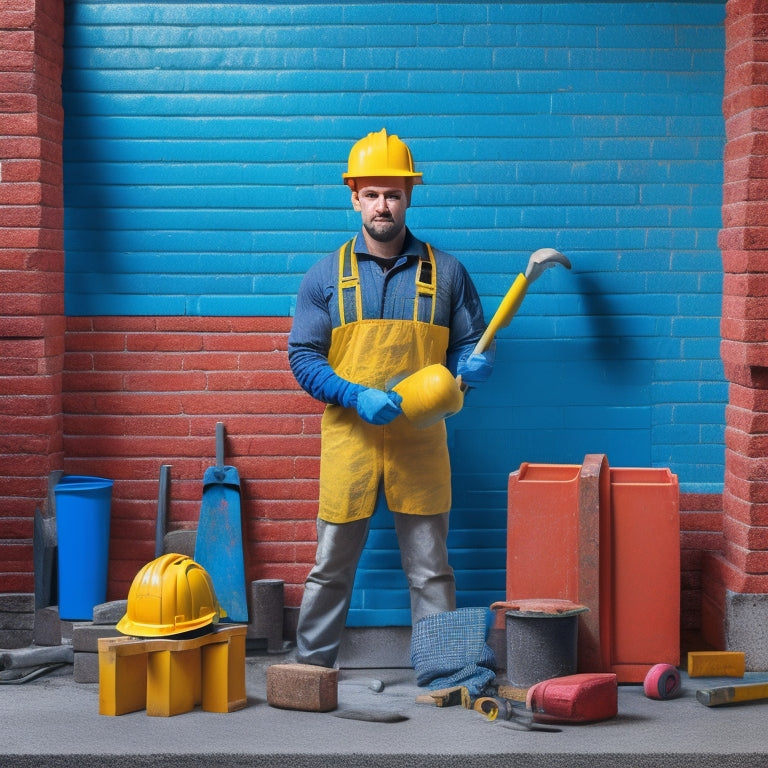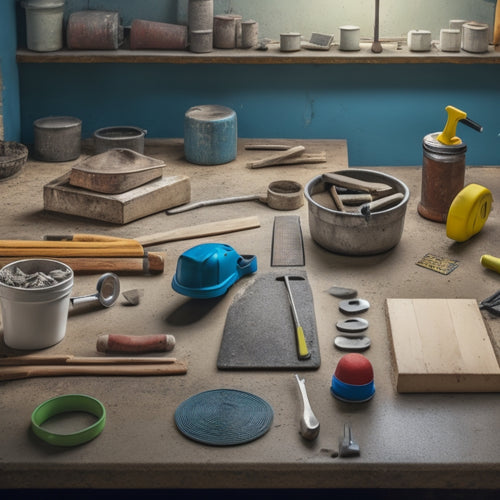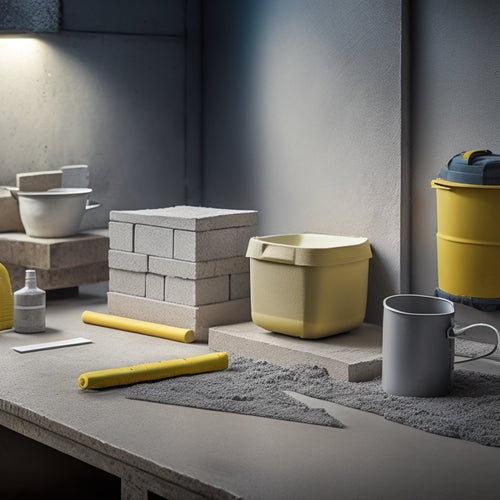
5 Best Tools for Building a Concrete Block Wall
Share
When building a concrete block wall, you'll need to invest in a range of tools to guarantee a sturdy and level structure. Start with reliable tamping tools for compaction, selecting durable handles and heavy-duty plates for consistent pressure. Next, choose the right blocks and mortar mixing essentials, considering load-bearing capacity, insulation needs, and aesthetic appeal. Don't forget leveling and alignment tools like laser levels and alignment strings, as well as cutting and chiseling tools like masonry saws and chisels. Finally, finish with jointers, pointing trowels, and surface treatments. With these tools, you'll be well on your way to a structurally sound and visually appealing wall - and understanding how to use them effectively is just the beginning.
Key Takeaways
• A reliable tamper is essential for achieving peak compaction and eliminating air pockets beneath the concrete block wall.
• A durable masonry saw and a set of chisels are necessary for cutting and chiseling blocks to fit perfectly.
• A laser level and alignment string are crucial for maintaining straight lines and ensuring the wall is level and plumb.
• A jointer or pointing trowel is needed for filling gaps and creating smooth surfaces between blocks.
• A high-pressure washer is required for cleaning the wall and preparing it for sealing, which protects it from the elements.
Essential Tamping Tools for Compaction
When compacting soil or gravel beneath your concrete block wall, you'll need reliable tamping tools to assure a solid foundation. A sturdy tamper is essential for achieving peak compaction, which is critical for the structural integrity of your wall.
Proper tamping techniques involve applying consistent pressure to eliminate air pockets and assure uniform density. This, in turn, provides numerous compaction benefits, including increased load-bearing capacity, reduced settlement, and improved drainage.
To achieve effective compaction, you'll require a tamper that can withstand the physical demands of the task. Look for a tool with a durable handle, a heavy-duty plate, and a comfortable grip.
A tamper with adjustable handles can be particularly useful, as it allows you to adapt to different soil types and compacting requirements.
Blocks and Mortar Mixing Essentials
With your compacted soil or gravel foundation in place, you're ready to start building your concrete block wall, which begins with selecting and preparing the right blocks and mortar.
You'll need to choose from various block types, including solid, hollow, and insulated blocks, each suited for specific applications. Consider factors like load-bearing capacity, insulation requirements, and aesthetic appeal when making your selection.
Next, you'll need to prepare the mortar, which is a vital component of your block wall. Mortar ratios are important, as they affect the strength and durability of the wall. A standard ratio is 1 part cement to 2.5 parts sand, but this may vary depending on the type of blocks you're using and local building codes.
Make sure to follow the manufacturer's instructions for mixing and applying the mortar. You'll also need to verify the mortar is mixed to the correct consistency, as this will impact the bond between the blocks.
Leveling and Alignment Tools Needed
Establishing a level and plumb wall is vital to the structural integrity of your concrete block wall. To achieve this, you'll need to arm yourself with the right leveling and alignment tools.
To guarantee your wall is perfectly level, you'll need a laser level. This tool projects a precise, self-leveling line that allows you to check the levelness of your wall course by course. Additionally, an alignment string is important for maintaining straight lines and proper alignment. This string is stretched along the top of the wall, providing a visual reference point for each block course.
When setting up your laser level, make sure it's calibrated correctly to guarantee accurate readings. Then, use the alignment string to guide your block placement, ensuring each course is straight and true.
As you build, regularly check your wall's levelness and plumbness using your laser level and alignment string. This combination of tools will help you achieve a structurally sound and professionally-looking concrete block wall.
Cutting and Chiseling Block Tools
Your concrete block wall project requires precise cutting and chiseling of blocks to fit around obstacles, corners, and edges, making the right cutting and chiseling tools essential for a professional-looking finish.
You'll need a variety of saws to tackle different cutting tasks. For instance, a masonry saw or a circular saw with a masonry blade is ideal for cutting blocks to size, while a reciprocating saw or an oscillating multi-tool is better suited for curved cuts or demo work.
When it comes to chiseling, you'll need a set of chisels specifically designed for concrete and masonry. Use a pointed chisel to remove small amounts of material, and a flat chisel for larger areas.
Chisel techniques are just as important as the tools themselves. Always wear safety goggles and gloves, and hold the chisel at a 20- to 30-degree angle to the block. Strike the chisel gently but firmly with a hammer, and work your way along the block in small sections.
Finishing Touches and Cleanup Tools
You'll need to move on to the finishing touches, ensuring your concrete block wall is level, plumb, and clean, which requires a set of specialized tools. A level and a plumb line will help you verify the wall's accuracy, while a jointer or a pointing trowel will aid in filling gaps and creating a smooth surface.
Next, you'll need to apply surface treatments to protect your wall from the elements. This may involve applying a sealant using various sealing techniques, such as spraying or brushing. A high-pressure washer can also be used to clean the wall and prepare it for sealing.
Additionally, a broom or a scrub brush can be used to remove dirt and debris from the wall's surface. For more stubborn stains, a chemical cleaner may be necessary.
Frequently Asked Questions
Can I Use a Regular Hammer to Tap Blocks Into Place?
When tapping concrete blocks into place, you'll want to choose the right hammer to avoid damaging the blocks or compromising their alignment.
A regular hammer can be too heavy-handed, potentially cracking the blocks or pushing them out of alignment.
Instead, opt for a rubber mallet or a specialized block hammer, designed to deliver a controlled, gentle tap.
These hammer types will help you achieve precise block alignment without risking damage.
How Do I Ensure Straight Lines in My Block Wall Construction?
Imagine building a skyscraper on a wonky foundation - it's a recipe for disaster!
Ensuring straight lines in your block wall construction is essential. To avoid costly mistakes, you'll need to get it right from the start.
Use a line level to check your wall's verticality, and a string line to guide your block placement. This combo will help you achieve a laser-straight wall, every time.
Can I Build a Block Wall on a Sloping Surface?
When building a block wall on a sloping surface, you'll need to address the challenges it presents.
First, make certain your sloping foundation is stable and compacted to prevent settlement issues.
Next, consider drainage carefully, as water can accumulate behind the wall, causing erosion and damage.
You'll need to incorporate a drainage system, such as a French drain, to direct water away from the wall.
With proper planning and execution, you can successfully build a block wall on a sloping surface.
Is It Necessary to Cure the Mortar Between Blocks?
When you're building a concrete block wall, you'll need to guarantee the mortar between blocks cures properly. This step is essential for block adhesion, as it allows the mortar to reach its full strength.
If you don't cure the mortar, it may not bond correctly, leading to a weakened structure. You'll want to keep the mortar moist for 24-48 hours, either by misting it with water or using a curing compound.
This will guarantee the mortar reaches its ideal strength and your wall remains stable.
Do I Need a Building Permit for a Small Block Wall Project?
As you envision your small block wall project rising from the ground, don't overlook an essential step: obtaining a building permit.
You'll need to navigate permit requirements, which vary by jurisdiction. Typically, permits are required for walls over a certain height or those that affect property lines.
Research your local regulations to guarantee compliance. Failure to obtain a permit can lead to costly rework or even demolition.
Don't risk it - get the necessary permits before breaking ground.
Conclusion
You've laid the final block, and your concrete wall is now a fortress of strength.
Like a conductor leading an orchestra, you've harmoniously wielded the right tools to create a masterpiece.
With every tap of the tamping tool, every mix of mortar, and every precision cut, you've built a wall that will stand the test of time.
Your hard work has paid off, and your concrete block wall is a symphony of stability and structure.
Related Posts
-

Must-Have Tools for Laying Concrete Tiles
When laying concrete tiles, you'll need a range of essential tools to get the job done right. Start with subfloor pre...
-

Essential Tools for Concrete Wall Covering Projects
When tackling a concrete wall covering project, you'll need a range of essential tools and equipment. For cleaning an...
-

What Tools Do I Need for Concrete Block Laying
You'll need a thorough set of tools to guarantee accurate, efficient, and professional concrete block laying. Essenti...


